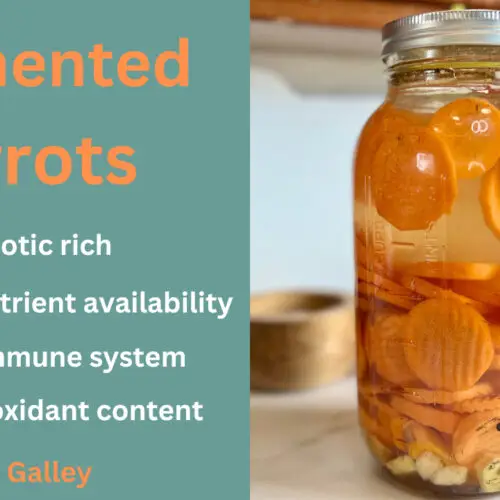Fermented Carrots
Fermented carrots contain probiotics, which are beneficial bacteria that help improve digestion and promote a healthy gut. They can also alleviate digestive issues such as bloating, gas, and constipation.
Equipment
- Fermentation weights Or something to hold the carrots under the Brine.
- Pickle pipes You can also use a piece of cloth or a coffee filter and a rubber band
- 1 Quart wide mouth mason jar
Ingredients
- Organic carrot Sticks or slices, enough to fill the jar. Washed and peeled. Organic is important so you know no pesticides have been sprayed on them. I think one pound normally does a quart jar.
- Sea Salt 1 Tbsp per one cup of water
- Filtered water No chlorinated water
Optional Add Inns
- 1 inch Fresh ginger diced
- 1 inch Fresh Turmeric diced
- 4 Whole peppercorns smashed
- 2-3 Cloves garlic smashed
- 1 Tbsp Dried dill
- A few sprigs of fresh dill
- 1 teaspoon of mustard seed and 1 teaspoon of caraway.
- 1 jalapeno pepper sliced in half along with a few slices of onion
Instructions
- Fill a measuring cup with 2 cups of filtered water and whisk in the sea salt.
- Add flavors that you choose to the jar first to keep them from floating. Then pack in carrots, making sure that the carrots are 1 inch below the top. Try to pack the carrots in tightly, then use a fermentation weight to keep them from floating above the brine. it is important that whatever weight you are using, the weights and all the carrots are below the brine level.
- Be sure to leave a bit of head room for bubbling. Be sure to use a jar that will allow gas to escape during the ferment.
- Add a fermenting lid or pickle pipe to the top, and then screw with a Mason jar band. Of a scrap of fabric and a rubber band.
- Place the carrots in a dark, room-temperature location (a kitchen cupboard is perfect). Let them ferment for a minimum of 14 days up to 28 days. After 14 days, the carrots will be deliciously fermented but still crisp. They will continue to soften the longer they ferment.
- Set the jar on a towel or plate to catch any possible brine overflow that will occur during the first week of fermentation
- White bubbles or foam on the top is totally normal! That's a sign of a healthy ferment.
- When you decide to end the fermentation period (a minimum of 14 days up to 28 days) is based on your taste preference. The longer the carrots ferment, the more their flavors will develop and their texture will slightly soften (yet still be crunchy). Open the jar and take a look. Most likely you’ll see a layer of kahm yeast on top. This is okay. With clean hands, reach in through the kahm yeast and remove the fermenting weight. Use a paper towel as a gripper if the weight is too slick. Remove any remaining kahm yeast. The good news is that the fermenting weight will take the bulk of the kahm yeast out with it. Next, use a paper towel to wipe off the remaining kahm yeast from the inside of the jar. You can also dab the surface with a paper towel (or use a spoon) to pick up the remaining kahm yeast flakes. Remember that kahm yeast is harmless so if some pieces remain, it’s ok!
- Replace the fermentation lid with a plastic wide mouth plastic mason jar lid and store in the refrigerator. They will last for many months.
Tried this recipe?Let us know how it was!
